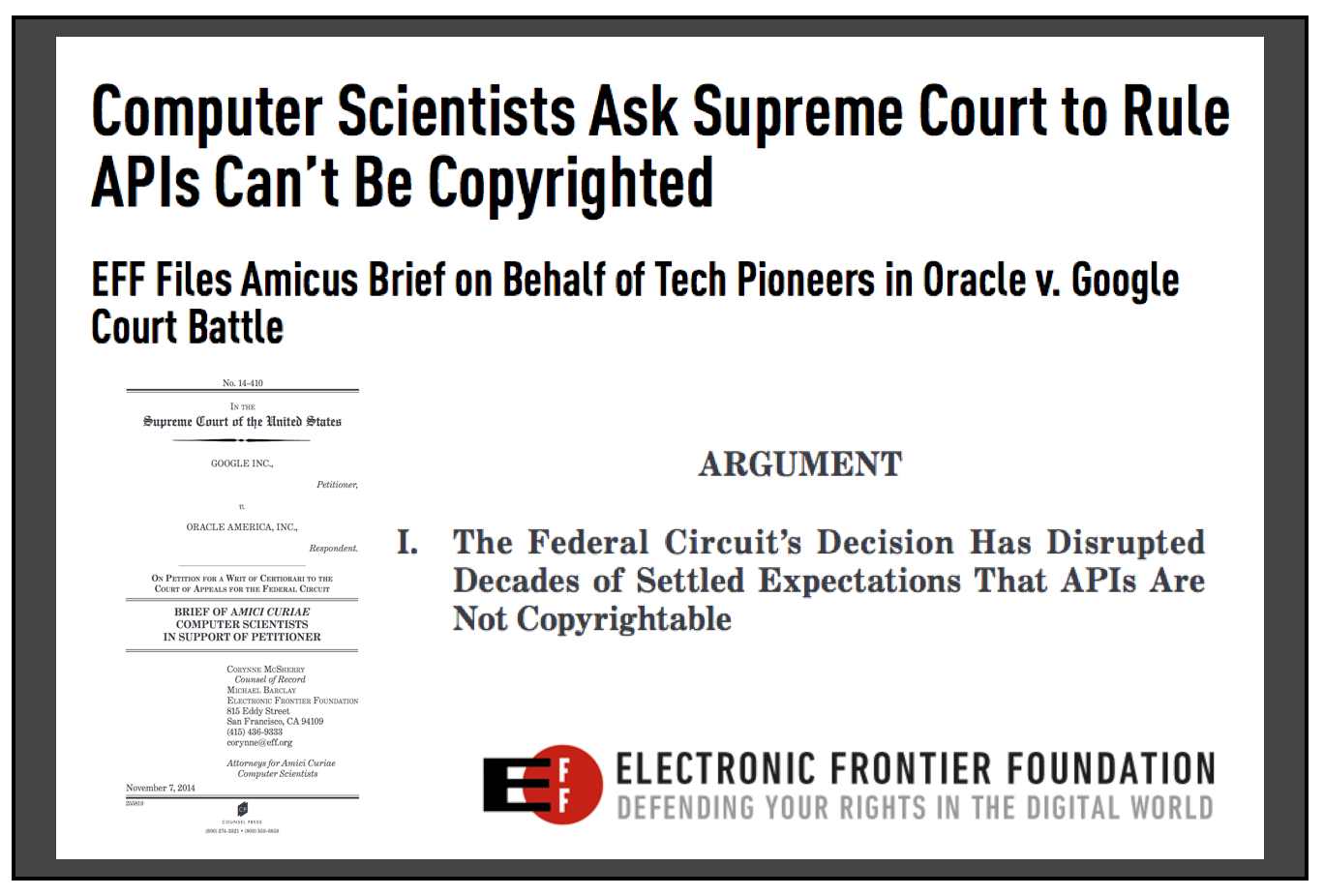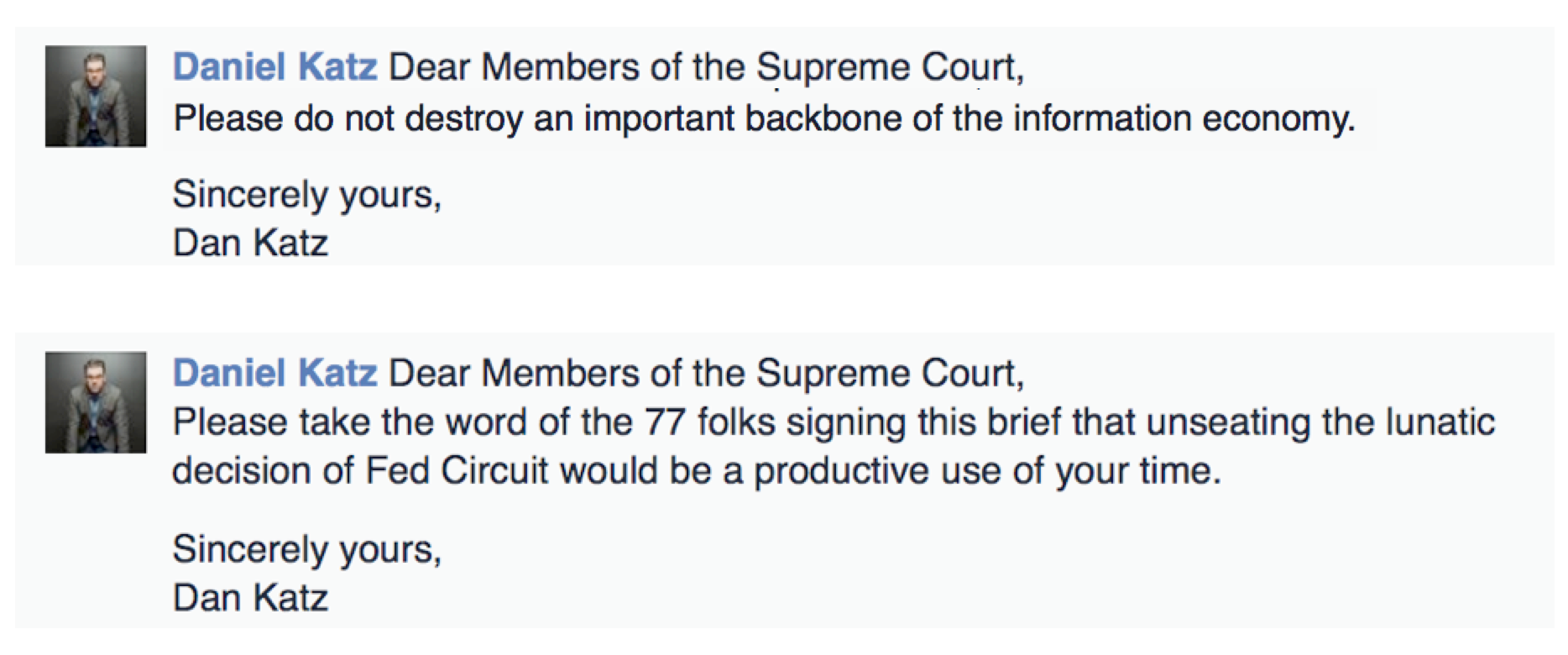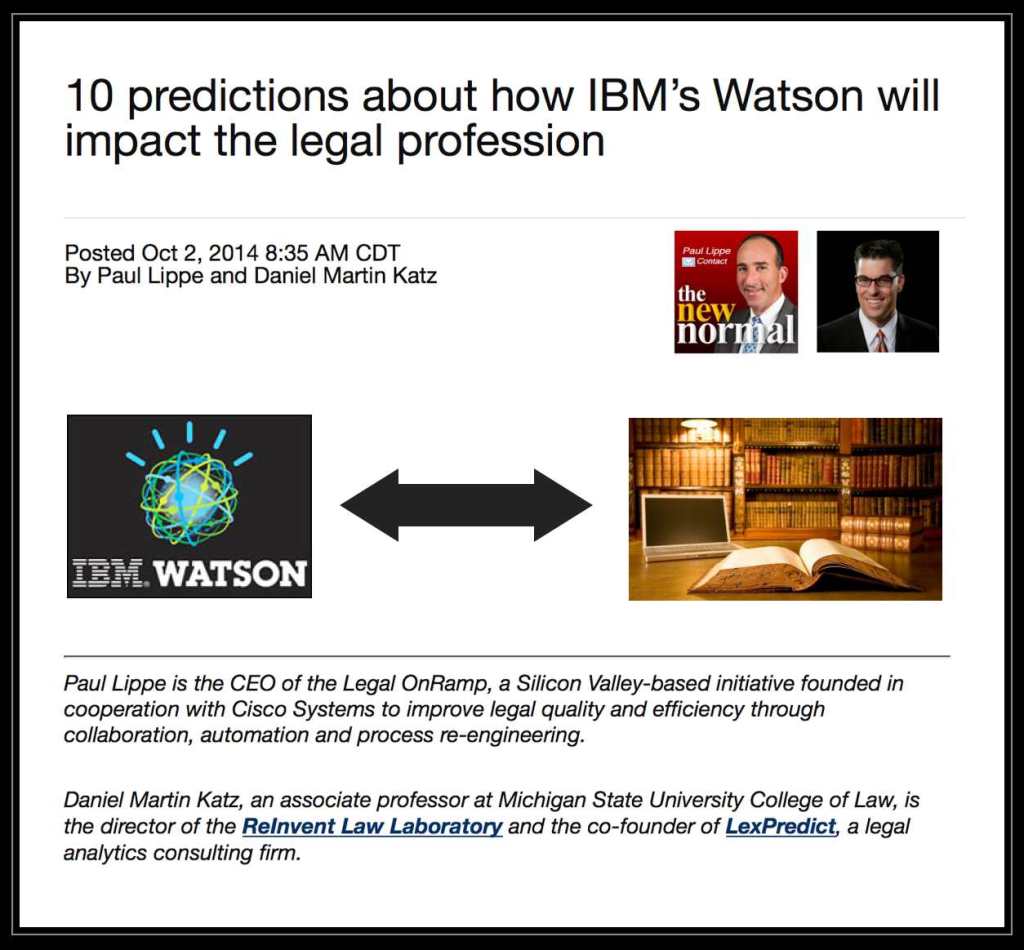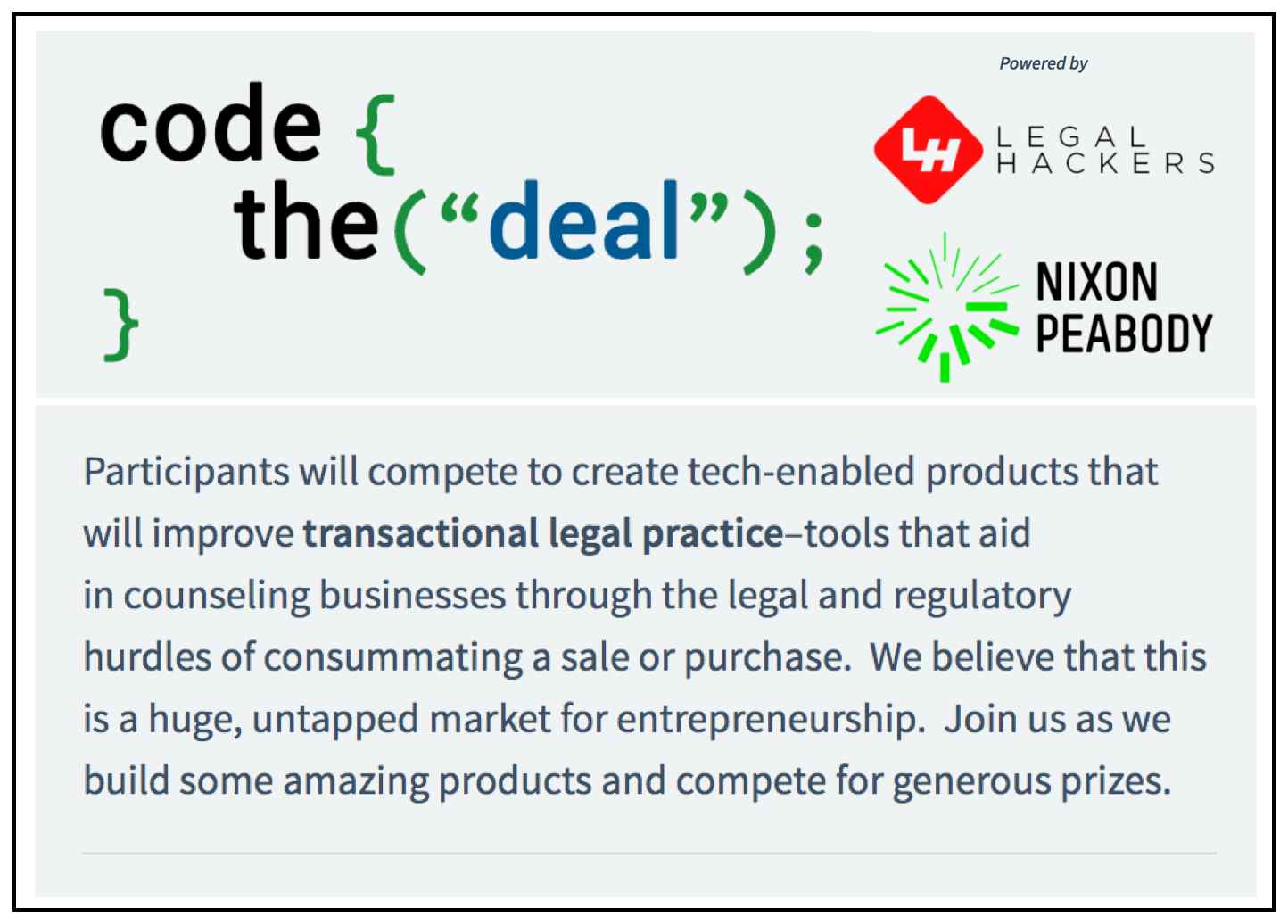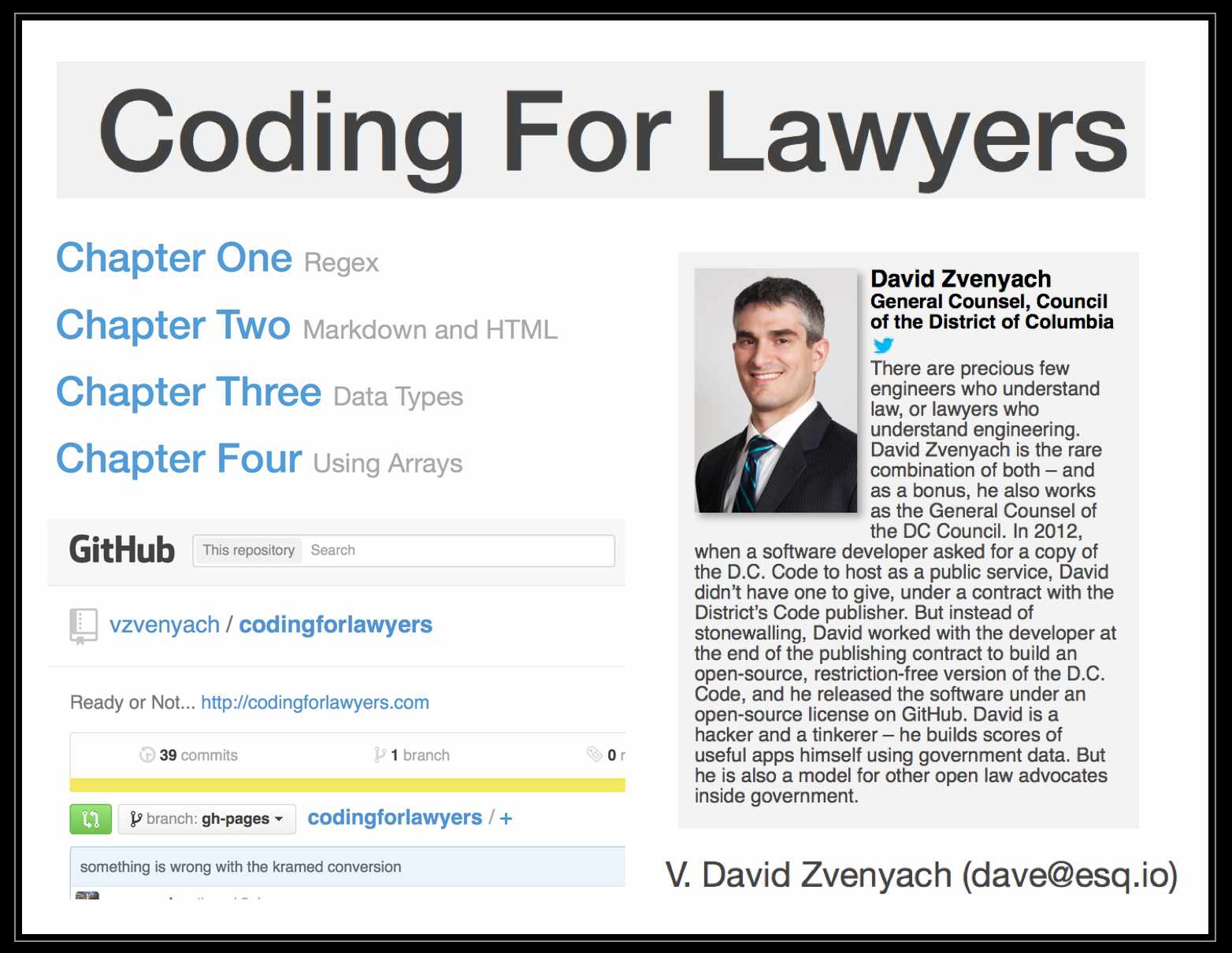–
The 19th Annual Law Firm Leaders Forum – NYC (Presented by Thomson Reuters Legal Executive Institute)
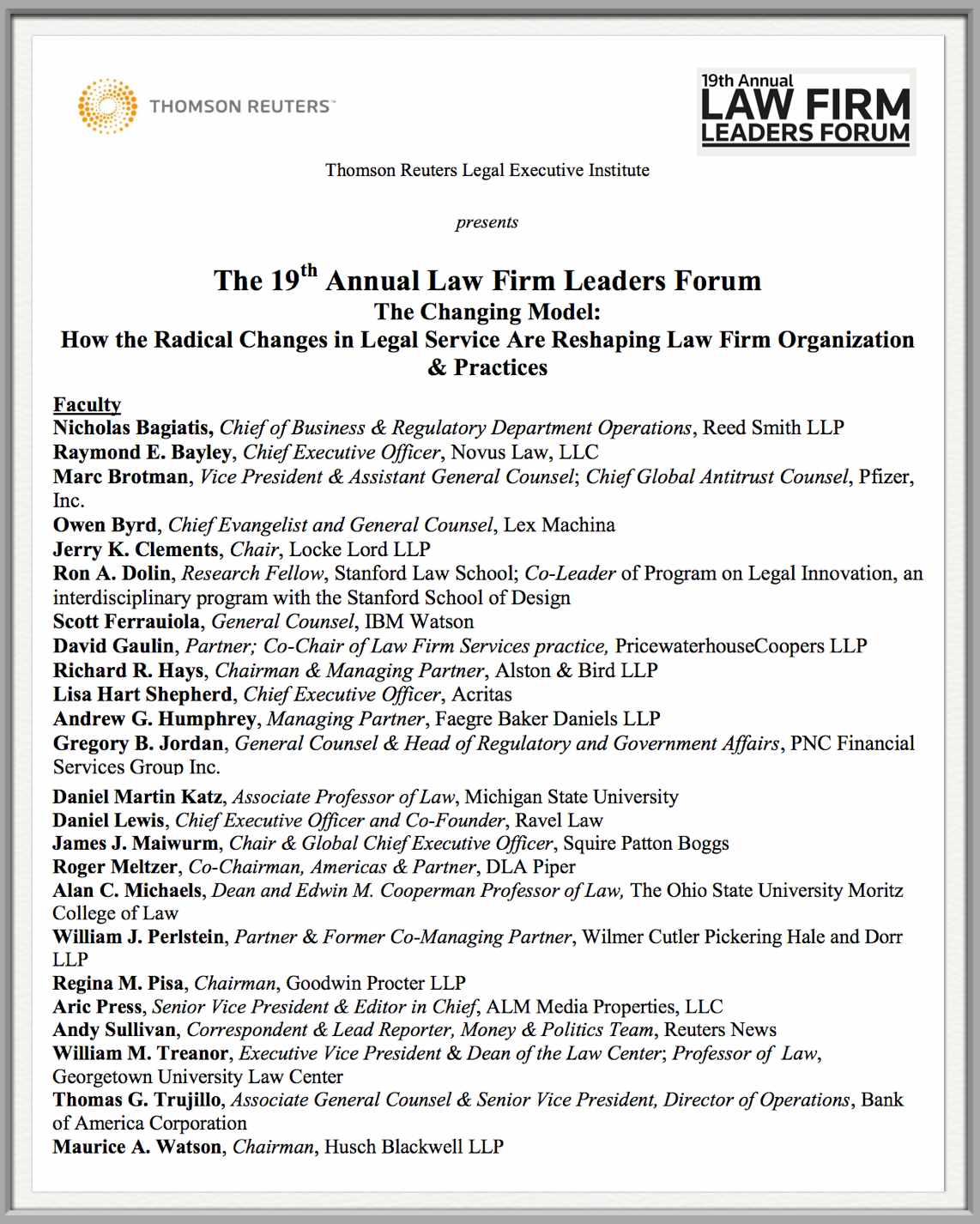 Tomorrow I will be speaking at the 19th Annual Law Firm Leaders Forum in NYC (Presented by Thomson Reuters Legal Executive Institute). This annual event draws a large number of leaders from the AMLaw 200 law firms. The focus of my panel will be the Emerging Role of Technology in the Law Firm Model. I am joined by a world class faculty which includes representatives from Law firms, In House, Legal Tech and the Legal Academy, etc.
Tomorrow I will be speaking at the 19th Annual Law Firm Leaders Forum in NYC (Presented by Thomson Reuters Legal Executive Institute). This annual event draws a large number of leaders from the AMLaw 200 law firms. The focus of my panel will be the Emerging Role of Technology in the Law Firm Model. I am joined by a world class faculty which includes representatives from Law firms, In House, Legal Tech and the Legal Academy, etc.
Law is Code: A Software Engineering Approach to Analyzing the United States Code
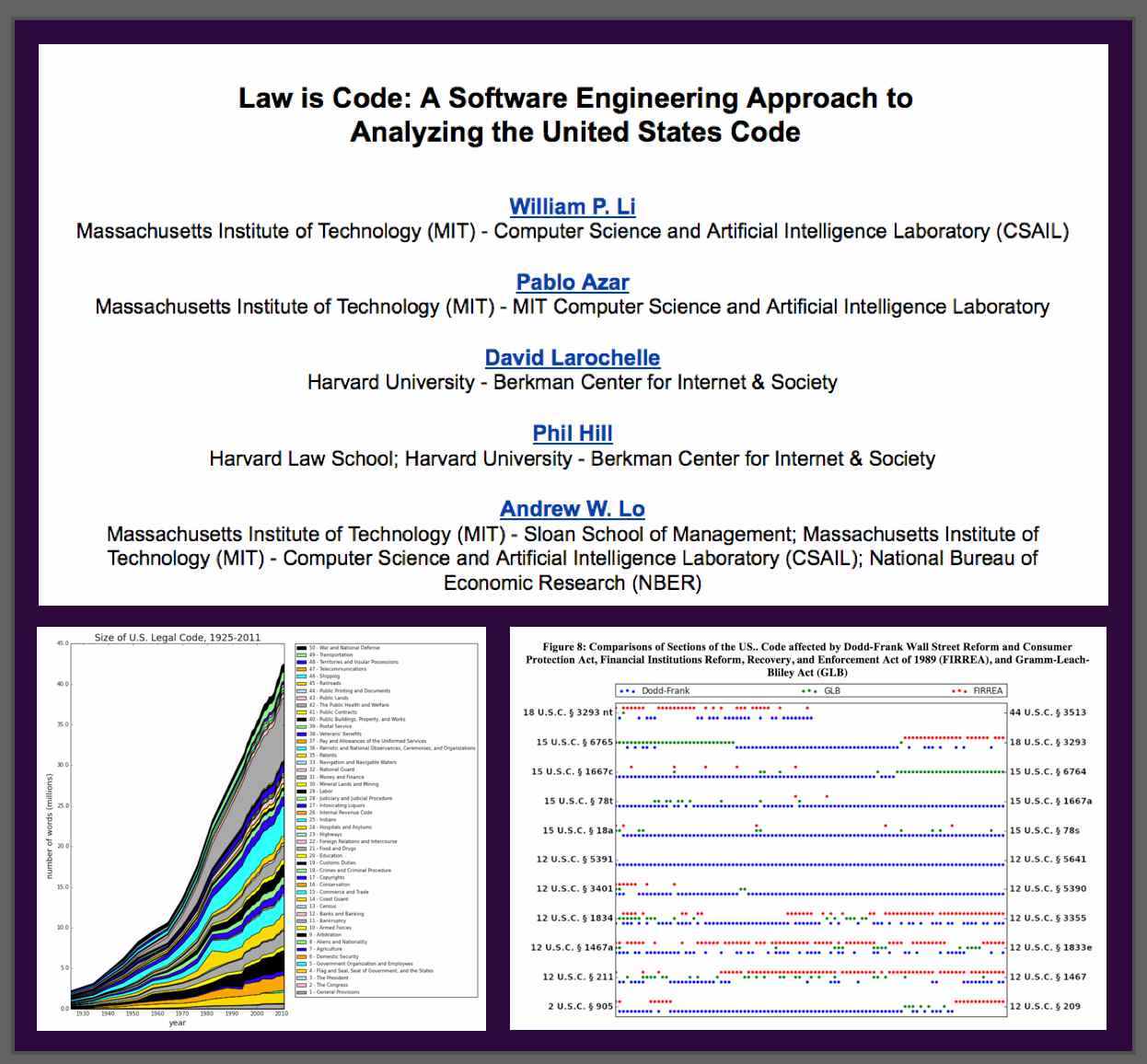 William Li, Pablo Azar, David Larochelle, Phil Hill & Andrew Lo, Law is Code: A Software Engineering Approach to Analyzing the United States Code
William Li, Pablo Azar, David Larochelle, Phil Hill & Andrew Lo, Law is Code: A Software Engineering Approach to Analyzing the United States Code
ABSTRACT: “The agglomeration of rules and regulations over time has produced a body of legal code that no single individual can fully comprehend. This complexity produces inefficiencies, makes the processes of understanding and changing the law difficult, and frustrates the fundamental principle that the law should provide fair notice to the governed. In this article, we take a quantitative, unbiased, and software-engineering approach to analyze the evolution of the United States Code from 1926 to today. Software engineers frequently face the challenge of understanding and managing large, structured collections of instructions, directives, and conditional statements, and we adapt and apply their techniques to the U.S. Code over time. Our work produces insights into the structure of the U.S. Code as a whole, its strengths and vulnerabilities, and new ways of thinking about individual laws. For example, we identify the first appearance and spread of important terms in the U.S. Code like “whistleblower” and “privacy.” We also analyze and visualize the network structure of certain substantial reforms, including the Patient Protection and Affordable Care Act (PPACA) and the Dodd-Frank Wall Street Reform and Consumer Protection Act, and show how the interconnections of references can increase complexity and create the potential for unintended consequences. Our work is a timely illustration of computational approaches to law as the legal profession embraces technology for scholarship, to increase efficiency, and to improve access to justice.”
Mike and I are excited to see this paper as it is related to two of our prior papers:
Daniel Martin Katz & Michael J. Bommarito II, Measuring the Complexity of the Law: The United States Code, 22 Journal of Artificial Intelligence & Law 1 (2014)
Michael J. Bommarito II & Daniel Martin Katz , A Mathematical Approach to the Study of the United States Code, 389 Physica A 4195 (2010)
The MIT School of Law? A Perspective on Legal Education in the 21st Century (Forthcoming in Illinois Law Review)
 ABSTRACT: “Despite some of the blustery rhetoric attendant to the ongoing market transition, lawyers and the market for legal services are not going away. Lawyers serve integral roles in a wide variety of social and political systems. Their work supports the proper functioning of markets and helps individuals and organizations vindicate their respective rights. At the same time, the processes associated with completing their work—as well as the contours of their respective expertise and judgment—are already changing. These changes are being driven by a number of economic and technological trends, many of which Larry Ribstein identified in a series of important articles published in the years before his untimely death.
ABSTRACT: “Despite some of the blustery rhetoric attendant to the ongoing market transition, lawyers and the market for legal services are not going away. Lawyers serve integral roles in a wide variety of social and political systems. Their work supports the proper functioning of markets and helps individuals and organizations vindicate their respective rights. At the same time, the processes associated with completing their work—as well as the contours of their respective expertise and judgment—are already changing. These changes are being driven by a number of economic and technological trends, many of which Larry Ribstein identified in a series of important articles published in the years before his untimely death.
This Essay is offered as part of a symposium honoring the work of the late Larry Ribstein. It is a thought exercise about a hypothetical MIT School of Law—an institution with the type of curriculum that might help prepare students to have the appropriate level of substantive legal expertise and other useful skills that will allow them to deliver value to their clients as well as develop and administer the rules governing markets, politics, and society as we move further into the 21st Century. It is a blueprint based upon the best available information, and like any other plan of action would need to be modified to take stock of shifting realities over time. It is not a solution for all of legal education. Instead, it is a targeted description of an institution and its substantive content that could compete very favorably in the existing and future market. It is a depiction of an institution whose students would arguably be in high demand. It is a high-level sketch of an institution that would be substantively relevant, appropriately practical, theoretically rigorous and world class.
Part I offers an introduction to the question. Part II sets the stage by highlighting several recent trends in the market for legal services. Taking stock of those trends, Part III highlights an alternative paradigm for legal education and describes the polytechnic style of legal education that students might obtain at an MIT School of Law. Part IV carries through on that basic thought experiment by describing the process of attracting, training, and placing students that would occur at MIT Law. Part V provides some concluding thoughts.”
Available at: Daniel Martin Katz, The MIT School of Law: A Perspective on Legal Education in the 21st Century, 2014 Illinois L. Rev (Forthcoming)
Announcing the All New LexPredict FantasySCOTUS – (Sponsored By Thomson Reuters)
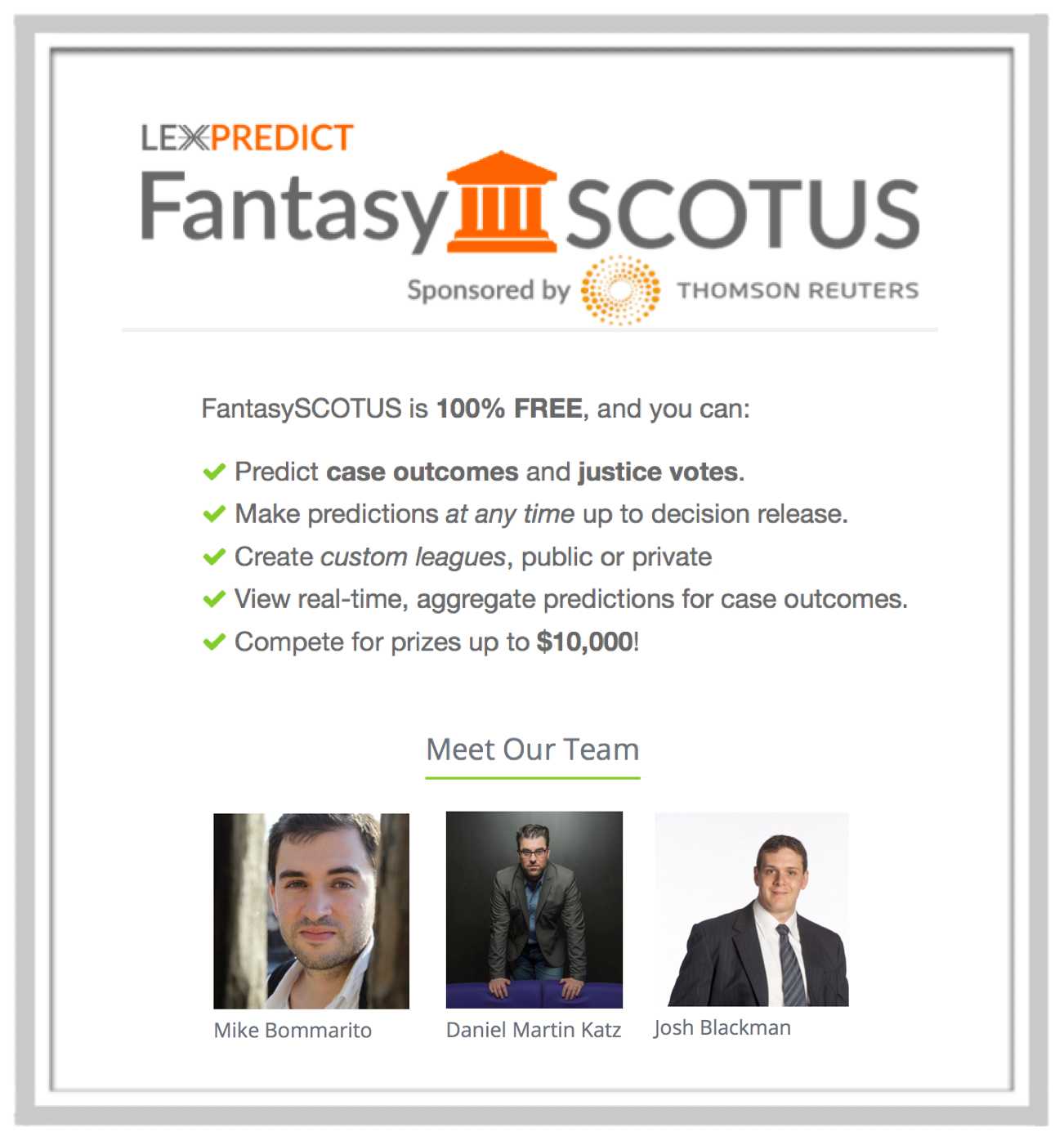 Today I am excited to announce that LexPredict has now launched the all new FantasySCOTUS under the direction of Michael J. Bommarito II, Daniel Martin Katz and Josh Blackman.
Today I am excited to announce that LexPredict has now launched the all new FantasySCOTUS under the direction of Michael J. Bommarito II, Daniel Martin Katz and Josh Blackman.
FantasySCOTUS is the leading Supreme Court Fantasy League. Thousands of attorneys, law students, and other avid Supreme Court followers make predictions about cases before the Supreme Court. Participation is FREE and Supreme Court geeks can win cash prizes up to $10,000 (many other prizes as well — thanks to the generous support of Thomson Reuters).
We hope to launch additional functionality soon but we are now live and ready to accept your predictions for the 2014-2015 Supreme Court Term!
The Utility of Text: The Case of Amicus Briefs and the Supreme Court (by Yanchuan Sim, Bryan Routledge & Noah A. Smith)
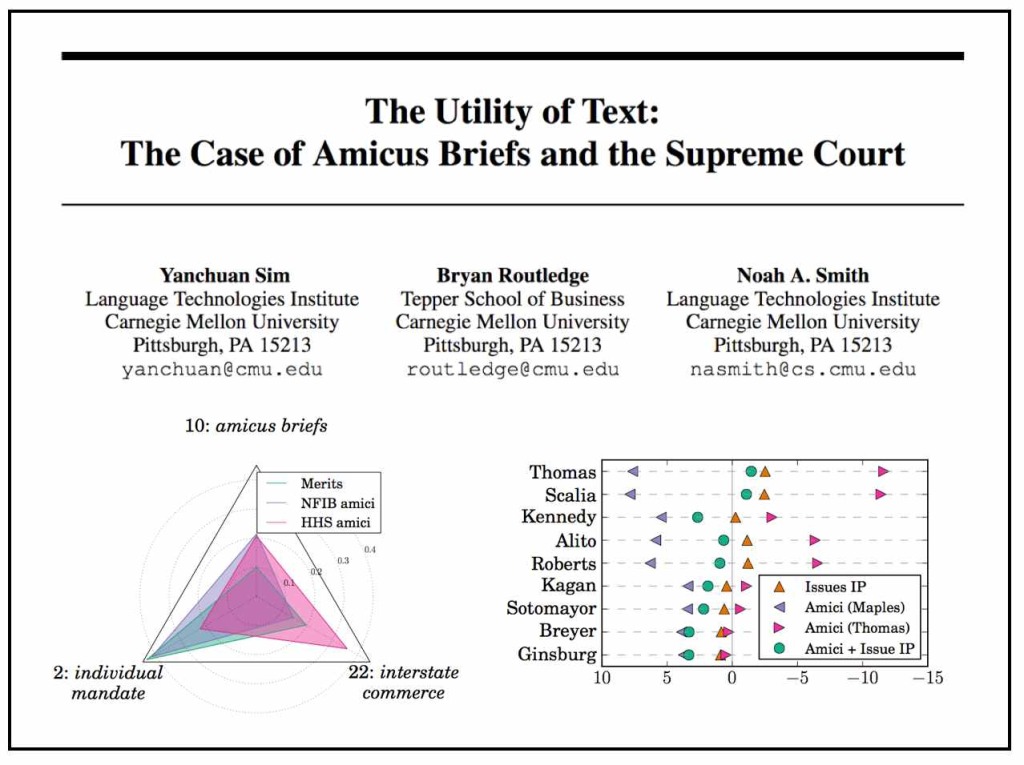 From the Abstract: “We explore the idea that authoring a piece of text is an act of maximizing one’s expected utility. To make this idea concrete, we consider the societally important decisions of the Supreme Court of the United States. Extensive past work in quantitative political science provides a framework for empirically modeling the decisions of justices and how they relate to text. We incorporate into such a model texts authored by amici curiae (“friends of the court” separate from the litigants) who seek to weigh in on the decision, then explicitly model their goals in a random utility model. We demonstrate the benefits of this approach in improved vote prediction and the ability to perform counterfactual analysis. (HT: R.C. Richards from Legal Informatics Blog)
From the Abstract: “We explore the idea that authoring a piece of text is an act of maximizing one’s expected utility. To make this idea concrete, we consider the societally important decisions of the Supreme Court of the United States. Extensive past work in quantitative political science provides a framework for empirically modeling the decisions of justices and how they relate to text. We incorporate into such a model texts authored by amici curiae (“friends of the court” separate from the litigants) who seek to weigh in on the decision, then explicitly model their goals in a random utility model. We demonstrate the benefits of this approach in improved vote prediction and the ability to perform counterfactual analysis. (HT: R.C. Richards from Legal Informatics Blog)
Five Observations Regarding Technology and the Legal Industry – My Keynote Presentation at Legal Week Global Corporate Counsel Forum – NYC 2014
It has been an exciting few days here in NYC as I was able to speak at the Legal Week Global Corporate Counsel Forum and also attend part of the IBM Watson launch at 51 Astor Place in NYC.
10 Predictions About How IBM’s Watson Will Impact the Legal Profession
I enjoyed collaborating with Paul Lippe for this short article in the ABA Journal New Normal column. We make 10 predictions about Watson’s application into the legal industry (some short term and some longer term) and preview some of our specific collaboration applying IBM Watson in the legal industry. Suffice to say there is much more to come …
Law Under the Data Deluge
Examples Law + Society as well as the Future of the Legal Profession including work by {Dazza Greenword @ MIT Media Lab, Us (i.e. Mike Bommarito and Dan Katz)} as well as many others …
14th FRAP – Finance, Risk and Accounting Management Perspectives Conference @ Oriel College – Oxford
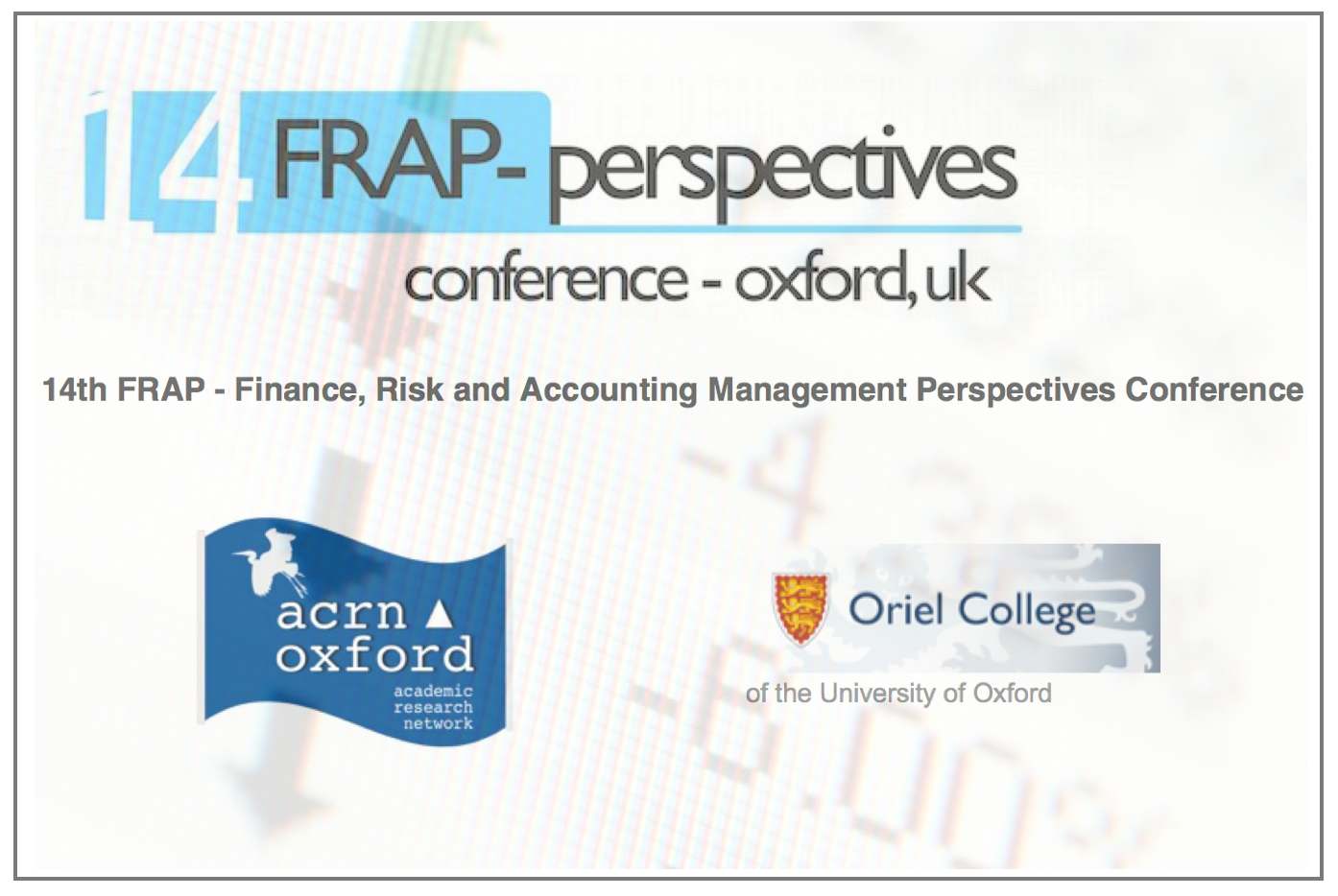 Tomorrow I will presenting initial results for my new project called ‘Law on the Market’ (co-authored with Jim Chen, Michael Bommarito & Tyler Soellinger) at the Oxford FRAP Finance Conference at Oriel College!
Tomorrow I will presenting initial results for my new project called ‘Law on the Market’ (co-authored with Jim Chen, Michael Bommarito & Tyler Soellinger) at the Oxford FRAP Finance Conference at Oriel College!

